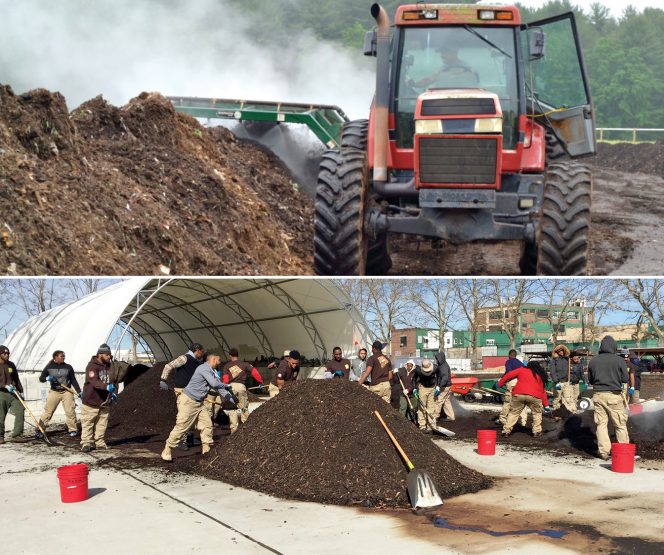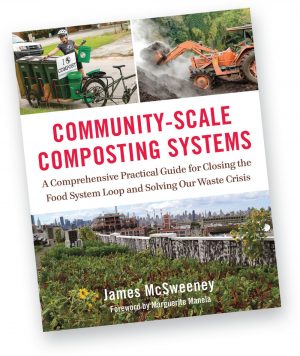New book, Community-Scale Composting Systems, covers a spectrum of topics related to composting program development and management.
Rich Flammer
BioCycle March/April 2019
Our current infrastructure is not designed to capture and efficiently utilize the abundance of resources that flow through our communities on a daily basis,” says James McSweeney, author of the new book, Community-Scale Composting Systems, A Comprehensive Practical Guide for Closing the Food System Loop and Solving Our Waste Crisis, when asked about the importance of community-scale composting. “We’ve had an [waste] import/export mentality. Increasing the residence time of those resources in a community by just a small percentage could mean a dramatic increase in that community’s productivity, and save a lot both economically and environmentally. So when we talk about community-scale systems, I think we’re really talking about changing that import/export paradigm.”
In the Introduction, McSweeney offers this definition of a community-scale composting system: “Inherent in the concept is the idea that the system has the capacity to capture and recycle a community’s organic waste stream. In reality, most community-scale composting systems target a specific portion of the waste stream, usually the most local, and usually the food scraps and yard waste of the community, as opposed to human or animal wastes.”
He includes a list of “Core Community Composting Principles,” and Number 4 notes that a community-scaled system “is diverse, distributed, and sustainable,” and “scaled to meet the needs of a self-defined community.” Throughout the book, McSweeney addresses a multitude of topics specifically geared to community-scale composters, including micro routes for food scraps collection, capacity and site assessment, common models and systems, and end uses and markets. It’s this local, community-based focus that anchors the foundation of closing the food system loop.
Community-Scale Composting Systems, however, is chock full of how-to’s and insights for any scale of composter. Writes McSweeney: “This is a reference on Composting with a capital C, with tons of useful information for any composting application.” During an interview with BioCycle, he added that “most of my knowledge about composting before writing this came from mentors, trainings, a few technical books, and my direct work with composters. I looked at this task as an opportunity to challenge a lot of the assumptions I had, particularly when it came to process and end use.”
Practitioner Focus
The true value of Community-Scale Composting Systems is McSweeney’s ability to combine and translate scientific data with the practical elements of composting gleaned from his hands-on experience. “I tried to write the book that I could go to in my consulting work to size a fan or an air duct for an aerated static pile (ASP) system,” explains McSweeney. “It was created by practitioners for practitioners. Those who have contributed to it have been making good compost and/or working with composters of all shapes and sizes, for a long time.”
Balancing the science and art, technical and practical, and mechanical, logistical and biological elements of composting is possibly the biggest challenge to those embarking on development and management of these complex systems. McSweeney successfully narrows that gap, and provides an invaluable compendium of information that is logically organized for the reader and written in an easy-to-digest, friendly style. Rather than being meant to read cover-to-cover, Community-Scale Composting Systems acts nicely as a flip through/go-to resource for compost-related topics.

McSweeney discusses the full suite of composting methods, including mechanically turned windrows (top) and human-turned windrows (above). Photos by James McSweeney and David Buckel
Food Scraps Focus
The book’s focus on food scrap composting was born out of McSweeney’s experience with this material, and serves as a solid base for discussion of all things composting and organic residuals management. “Food scraps are a high-value resource to communities and the book covers ways to mitigate the distinct challenges that come with food scrap composting,” he writes. “It contains detailed yet understandable design methods for all of the common methodologies, including ASP systems, and it also contains a long chapter on integrating animal feeding.”
The comprehensiveness of this book cannot be overstated, covering topics that have never been combined and addressed with the fundamental elements of composting between two jacket covers. These include: “Feedstock Economics,” “Nutrient Management Planning,” “Systems for Composting with Animals,” “Compost Heat Recovery,” “Tipping, Swapping, and Washing” [compost carts or buckets], “Mitigating Persistent Herbicides,” “Micro Collection,” and “Hacking Equipment, Infrastructure and Functionality,” among many others.
I often turn to Roger Haug’s fine work, The Practical Handbook of Compost Engineering, for technical answers, but it isn’t written for the layperson. Many of the formulas and insights require an in-depth knowledge of composting systems and mathematical principles related to planning and design elements.
McSweeney’s Community-Scale Composting Systems rests at the other end of the spectrum in terms of practicality and value to composters at every level of proficiency and knowledge. Included are hierarchial considerations (animal feed systems, when possible before microbial composting), collection, site design planning and configurations, feedstock management and recipe mix formulation, system selection, process management at a multitude of levels, vector, leachate and odor control and minimization, and finished product testing, quality control and marketing. If it’s a topic related to composting system development and management, it’s very likely included in the book and explained in a technical, yet easy to understand manner.
At 464 pages, “Community-Scale Composting” — published by Chelsea Green — has ample volume to explain an entirely inclusive range of issues related to composting program development and management. Yet, as a testament to the book’s comprehensiveness and author’s desire to cover all things composting, McSweeney notes, “I had hoped to write entire chapters about compost heat recovery, and to talk more about vermicomposting systems design, but we had to let those topics go. There’s a long list of unfinished thoughts and ideas for future work.” Based upon the comprehensive study and presentation of this current volume of composting dynamics, we can only look forward to further insightful, comprehensive works by this composting practitioner.
Rich Flammer of Hidden Resources, a BioCycle Contributing Editor, is a composting and zero waste consultant (www.compostingconsultant.com).














